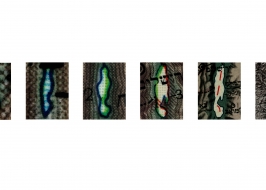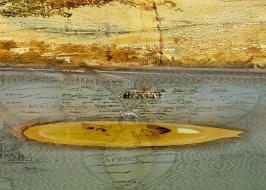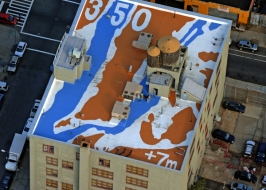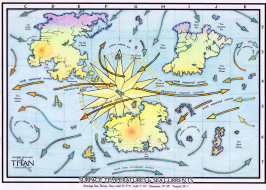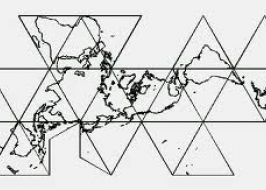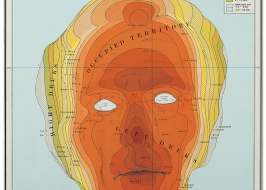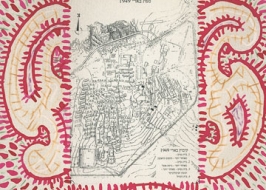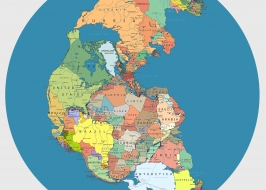Map "Mapping in Science and Art"Arthur and Rochelle Belfer Building for Biomedical Research
You are Here
In one of the more memorable scenes in The King and I, Anna (played by Deborah Kerr in the movie), points to Siam on a map of the world. The king’s many children raise a hue and cry: The Siam they know is a large, glorious and populous country. It is not, as the songwriter Meir Goldberg put it, “half a pin on the map of the world” (Eretz Ktana Im Safam).
That scene immediately pops to mind when we look at Deganit Berest’s Atlas series. Images of Eretz-Israel are conscribed within the outlines of maps drawn on different scales taken from the Physical- Political-Economic Atlas of Dr. Moshe Brawer. The drawings are to scale, so that in one, based on the map of Eretz-Israel (1:250,000), the details are clear, while in an enlargement from the economic map of the world (1:200,000,000), the country appears as a collection amorphous blots. (In the series, six black-and-white photos of maps, shown in increasing scale, are painted over in watercolor.) The fading of the print, the loss of shape and form leads us to contemplate our relative place in the world – of ourselves and our national identity. The Dead Sea series – different subject, same treatment – yields the same message: Know your true size in the grand scale of things, as well as in the context in which you find yourself, and act with the fitting humility.
Maps can be guides that help us to understand our place (and not just how to find our way from one point to another). The key phrase on this kind of map is “You are Here.” That holds true even on a map that depicts pathways of cell death, such as that of Prof. Adi Kimchi of the Molecular Genetics Department at the Weizmann Institute. This image maps out the possible routes that can be taken by most of the cells in our bodies; thus the “you are here” in this case is all the points on the map of roads to death. This map may not help us find our way, and it cannot tell us from where we came – but it gives us an excellent idea of the direction we are heading.
Part of the secret charm of cartography is the fact that it reduces a part of the world to a simple, square existence. The fact that maps are abstract and streamlined (even to extremes) is testament, more than anything, to the intellectual abilities of their creators, who have separated the wheat from the chaff and sifted out extraneous details to leave us with a “skeleton” that is to the point and which can show us, with an arrow, where we are on the map. This is a metaphor – an imitation of reality that does not pretend to encompass all of reality. It is a model that enables us to deal with a “real thing” that is too big, too complex, too small, too far away or simply hidden from our sight. Michael Druks’ Israeli Pattern, drawn on a map of Israel, or his maps created with Burda sewing patterns, are thus a sort of model on a model. The association here – maps and scissors – recalls an image from the book Dolly City, (Orly Kastel-Bloom, 1992), in which a woman carves the borderlines of Eretz-Israel onto the back of a baby.
Map, Map on the Wall – Mapping in art and science is arranged as a sort of continuous “zoom out” (with a few exceptions). Maps of intracellular processes lead to maps of the body, the soul, the city, the continent, the world – out to maps of the Universe. The works of scientists and artists are presented side by side (scientific images tend to be along the edges, artworks in the center) and are thus interwoven in our minds as we chart our path, creating a broad, layered “database” that, with a little processing, will eventually yield a disembodied voice that tells us: “You have reached your destination. Please calculate a new route.”
Several people helped us immensely in bringing together this exhibit. First and foremost, Prof. Katy Börner of Indiana University and Dr. Galia Bar Or, director of the Artists’ Colony, Ein Harod; and Tali Tamir and Avital Geva. Special thanks also go to the curators of map exhibits that were recently exhibited in Israel and which inspired this one: Dr. Dror K. Levy, Dr. Yael Eilat Van-Essen and Dr. Sayfan G. Borghini, curators of the exhibit The Cartography of the Unseen at the Holon Institute of Technology; and Simon Levy, curator of the exhibit Revealing the Concealed at the P8 Gallery.
Curator: Yivsam Azgad

